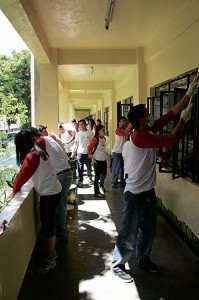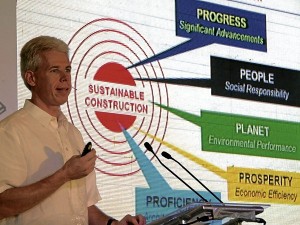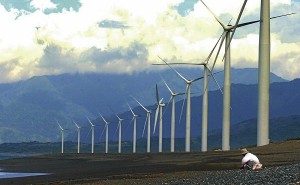Cement maker a champion of ‘green’
Holcim Philippines has no qualms in admitting that its main product, cement, is by no means what you can consider “green material.”
And yet the local unit of Swiss cement supplier Holcim Ltd. continues to be a staunch advocate of sustainable principles in the Philippine construction industry, believing that as a manufacturer of construction materials it also has much to share on how to make projects sustainable.
“While we do not build the projects ourselves, we try to influence our customers and other stakeholders by actively promoting sustainability in construction,” says Roland van Wijnen, chief operating officer of Holcim Philippines.
Green, sustainable principles
In the same breath, Holcim has also been hauling great efforts in ensuring that its own operations would likewise adhere to the same green and sustainable principles that it has been championing.
After all, manufacturing cement is such a resource- and energy-intensive process that has driven Holcim to continuously endeavor to find ways to reduce its impact on the environment.
Wijnen explains that the founders of Holcim have long realized that their operations have a tremendous impact on the environment, and disregarding this fact would not only create a community backlash but would also badly damage the environment they work in.
In short, taking care of the environment and affected communities has given Holcim the license to operate, he adds.
“So wherever the Holcim Group operates, we make sure that we minimize our impact on the environment by properly planning how we will harness the resources there and investing in technology that mitigate the effects of our operation. We also make sure we involve the community by educating them about our operations and letting them know that we can help in their development by providing opportunities and support for projects in the area,” Wijnen adds.
As such, Holcim places sustainability at the heart of its business strategy to create value for its stakeholders.
“We strive to integrate eco-practices in all areas of operation—seeking to reduce or minimize our carbon footprint from manufacturing to sales, and investing in technologies that keep the air and water clean. In protecting our environment, we work in partnership with our various stakeholders. When there are opportunities for doing so, we integrate livelihood with environment protection,” he further relates.

HOLCIM also supplied cement for the construction of the Monastery of the Transfiguration in Bukidnon. Photo by Christine M. Ang
“Throughout the Holcim Group, we are focused on bringing down carbon dioxide (CO2) emissions through a variety of approaches. One of the most effective technically-proven ways is by reducing clinker factor, which is done by using mineral components as alternative materials,” Wijnen explains.
Continuous emission monitoring
In the country, Holcim Philippines was the first cement plant to invest in a Continuous Emissions Monitoring Systems and to ensure that its emissions are within permissible levels set by the Holcim Group.
“It is interesting to note that the standards set by the Holcim Group are even more stringent than the local regulations. For instance, the Clean Air Act emission limits for dust and sulfur oxide are three times higher than the Holcim Group’s ceiling,” Wijnen discloses.
Holcim Philippines has also increasingly used alternative fuels and raw materials in its manufacturing process. Through a globally accepted technology called co-processing, the cement firm is able to process waste streams in our cement kilns, thus allowing for the safe and effective disposal of many types of wastes, including hazardous industrial wastes.

HOLCIM Philippines head office employees during their Community Service Day at the Tenement Elementary School in Taguig.
This is then supplemented by a careful maintenance program to ensure that the company’s equipment are at optimal performance, thus allowing for more efficient energy consumption.
Quarry rehabilitation policy
“Even as we continue to depend on mining operations to provide for our raw materials, our progressive quarry rehabilitation policy ensures that these sites can be used productively by the community even before they are completely mined out,” Wijnen says.
Holcim’s respect for nature is clearly evident in its program for restoring its quarries.
“We are the first cement company to submit a Final Mine Decommissioning and Rehabilitation Plan to the Department of Environment and Natural Resources and this has become our blueprint for progressively restoring quarry sites,” he further adds.
A visit to the company’s Lugait facility, according to Wijnen, would reveal that these quarry sites no longer look like quarries as they have already replanted these areas with native species and have attracted wildlife back.
“Interestingly, our Lugait facility has been listed among the province’s eco-tourism destinations a proof that responsible manufacturing is not detrimental to nature,” he concludes.
















